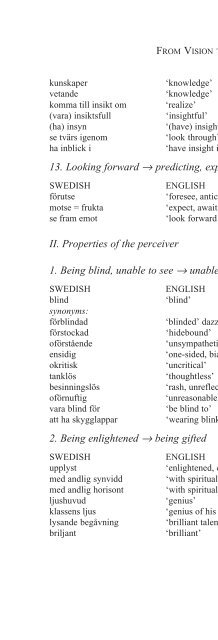Cognitive Semantics : Meaning and Cognition
Cognitive Semantics : Meaning and Cognition
Cognitive Semantics : Meaning and Cognition
Create successful ePaper yourself
Turn your PDF publications into a flip-book with our unique Google optimized e-Paper software.
CONCEPTUAL ENGINEERING 163<br />
Figure 8 depicts the situation. [ROW] predicates a processual motion path,<br />
placed spatially above the [SHOAL] or [HILL] predications by [ABOVE]. At the<br />
input level, this works fine in both cases, because there [HILL] <strong>and</strong> [SHOAL]<br />
have the same predications. However, when we enter the whole level of each,<br />
they differ. A whole could be said to be the surrounding of each of its parts.<br />
The whole of [SHOAL] thus also has [(SEA-)WATER] as a part (i.e. [SHOAL] <strong>and</strong><br />
[(SEA)WATER] are siblings), while [HILL] has [AIR] as a sibling.<br />
[ROW] has a number of sibling units, among them [(SEA-)WATER]. When<br />
[ROW], [ABOVE].TR <strong>and</strong> [SHOAL] superimpose, the [(SEA-)WATER] unit of [ROW]<br />
will coincide with the [(SEA-)WATER] unit of [SHOAL]. This is of course fine,<br />
since [(SEA-)WATER] easily superimposes onto itself. However, when [ROW],<br />
[ABOVE].LM <strong>and</strong> [HILL] superimpose, [(SEA-)WATER] will coincide with [AIR],<br />
<strong>and</strong> these two units do not superimpose easily.<br />
The basic principle here is the same as when parts were superimposed<br />
(Figure 7): When lexical units are mapped onto each other, it is done because<br />
they coincide in the composite structure. When two lexical units coincide, it<br />
must be possible to superimpose them into being one unit. To simulate this is a<br />
central goal in our implementation project.<br />
Along with the superimposition operations we have seen so far, Domain<br />
identification, Predication identification, Part <strong>and</strong> Whole accommodation,<br />
there are also a number of operations that alter the processing in various ways.<br />
They often appear after anomalies occur, but some seem to be invoked without<br />
having to be triggered by anomaly. In our project we mean to investigate the<br />
order of invocation between these semantic operations.<br />
Figure 9.















